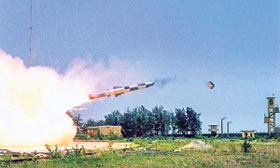May 2018 Science and Technology
Sakshi Education

- India successfully test- fires BrahMos from Integrated Test Range in Odisha
India on 21st May successfully test- fired BrahMos, supersonic cruise missile from the Integrated Test Range in Balasore, Odisha as part of service life extension programme.
The life extension test firing of BrahMos was conducted from a Static Inclined Launcher, proving the efficacy and longevity of the system. Defence Ministry in a release said, the precision strike missile flew in its designated trajectory and the key components functioned perfectly.
BrahMos is a joint venture between DRDO and NPOM of Russia. The highly versatile BrahMos has emerged as the ultimate weapon of choice in modern warfare with its unmatched speed, precision and firepower.
- Scientists discover solar system’s first interstellar immigrant
Scientists have discovered the first known permanent immigrant to the solar system – an asteroid, currently nestling in Jupiter’s orbit that migrated from another star system. All of the planets in our solar system, and the vast majority of other objects as well, travel around the Sun in the same direction.
However the immigrant asteroid named (514107) 2015 BZ509 is different – it moves in the opposite direction in what is known as a ‘retrograde’ orbit. “How the asteroid came to move in this way while sharing Jupiter’s orbit has until now been a mystery,” said Fathi Namouni, from National Scientific Research Centre (CNRS) in France.
The team ran simulations to trace the location of 2015 BZ509 right back to the birth of our solar system, 4.5 billion years ago when the era of planet formation ended. These show that 2015 BZ509 has always moved in this way, and so could not have been there originally and must have been captured from another system.
The discovery of the first permanent asteroid immigrant in the solar system has important implications for the open problems of planet formation, solar system evolution, and possibly the origin of life itself.
Understanding exactly when and how 2015 BZ509 settled in the solar system provides clues about the Sun’s original star nursery, and about the potential enrichment of our early environment with components necessary for the appearance of life on Earth.
- Researchers build world's 1st wireless insect-sized drone in US
A team of researchers at the University of Washington in the United States has built the world's first wireless fly-sized drone. It can easily slip into tight places inaccessible to big unmanned aerial vehicles.
It represents a milestone in autonomous flight that could launch a new wave of innovation in aerial robotics. The research team included three Indians- Professor Shyam Gollakota and PhD students Vikram Iyer and Yogesh Chukewad.
The University said in a statement that the insect-sized flying robots could help with time-consuming tasks like surveying crop growth on large farms or sniffing out gas leaks.
- Scientists discovered the fastest growing black hole of the universe
 Scientists have discovered the fastest-growing black hole known in the universe, describing it as a monster that devours a mass equivalent to our Sun every two days.
Scientists have discovered the fastest-growing black hole known in the universe, describing it as a monster that devours a mass equivalent to our Sun every two days.
The astronomers have looked back more than 12 billion years to the early dark ages of the universe, when this supermassive black hole was estimated to be the size of about 20 billion suns with a one per cent growth rate every one million years.
The energy emitted from this newly discovered supermassive black hole, also known as a quasar, was mostly ultraviolet light but also radiated x-rays.
The SkyMapper telescope at the ANU Siding Spring Observatory detected this light in the near-infrared, as the light waves had red-shifted over the billions of light years to Earth.
The discovery of the new supermassive black hole was confirmed using the spectrograph on the ANU 2.3 metre telescope to split colours into spectral lines.
- IISER Kolkata develops a new device to detect and remove arsenic from water
In a major breakthrough to tackle arsenic contamination in West Bengal, the Indian Institute of Science Education and Research, IISER Kolkata has developed a new device which can be used to detect and remove arsenic content from water and make it safe and usable by households.
IISER Director Sourav Pal said in a press conference that the device, 'Arsenic Sensor and Removal Media, developed in collaboration with a private company, is an effective system with low production cost.
An IISER research team, led by Dr Raja Shunmugam, developed the arsenic sensor which would show an immediate change in colour in arsenic contaminated water.
West Bengal has the highest number of arsenic-affected people in the country. In 83 blocks in eight districts of the state, groundwater is affected by arsenic contamination.
- Plans to launch first ever helicopter to Mars in 2020: US space agency NASA
 The US space agency, NASA has said it plans to launch the first ever helicopter to Mars in 2020. Known as the Mars Helicopter, the device weighs less than 1.8 kilograms and its main body section, or fuselage, is about the size of a softball.
The US space agency, NASA has said it plans to launch the first ever helicopter to Mars in 2020. Known as the Mars Helicopter, the device weighs less than 1.8 kilograms and its main body section, or fuselage, is about the size of a softball.
The Mars 2020 rover - accompanied by its helicopter companion is due to launch in July 2020 and arrive on the red planet in February 2021.
Administrator of NASA, Jim Bridenstine said in a statement that the agency has a proud history of firsts and the idea of a helicopter flying the skies of another planet is thrilling. No nation has ever flown an helicopter on Mars before.
The helicopter is equipped with solar cells to charge its lithium-ion batteries, and a heating mechanism to keep it warm through the cold Martian nights.
Published date : 04 Jul 2018 12:44PM



















